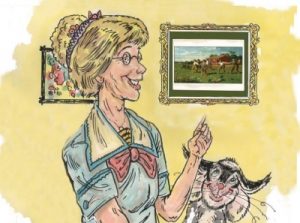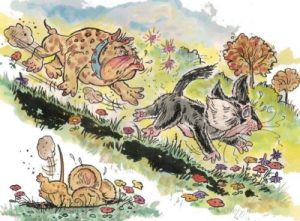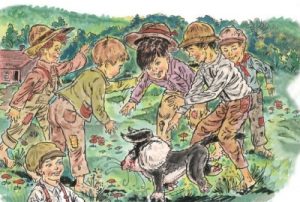Last year I reviewed a book for this site called The Not So Secret Life of Nimh, a book about a dumbo rat and rat care. Long ago, in a universe somewhat parallel to this one, the author sent me another book to review about a cat who enjoys art and experiences it in a unique way. This was a digital copy, which I saved to my computer and backed up onto a memory stick. Shortly afterward my computer died, as did its replacement. It has taken me until now to get things together, but I can finally review this cute little story of Gatsby the cat for you.

Cover for Gatsby’s Grand Adventures, Book 1. Story by Barbara Cairns, Illustrated by Eugene Ruble. Cover art by Eugene Ruble
There is magic in these pages, much like the magic of Blues Clues, the television show from Nick Junior, where Blue the dog and a human friend (either Steve or Joe) “skidoo” into a picture on the wall. In that new place they have traveled to, they are able to interact with the image, usually by talking to characters within the picture. Gatsby the cat has a similar power: his tail twitches, his nose itches and his haunches hitch before he leaps into a painting that is part of the art gallery he lives in. Each book is about a different painting. This first installment focuses on Winslow Homer’s “Snap the Whip.”
Art and Animal Behavior
Gatsby loves art and loves to jump in paintings. The story itself is cute, though there isn’t much purpose in it other than to teach the reader a little about the painting itself. Reading about Gatsby’s adventure, you can discover a few things about this particular work of art:
- The name of the painting- The title of the painting is clearly written three times within the story of Gatsby the cat. As a teacher, this is always an important thing for me to see. Repetition is how most of the youngest readers pick up those sometimes hard to remember details.
- Who painted the painting- The artist is mentioned three times in this story, all in the appropriate context as the creator of the work of art. Children reading this book also become accustomed to the way adults talk about art being “by” an artist or that the painting belongs “to” an artist, such as when Miss Annabelle says “My Winslow Homer painting is magically restored.” on the final page of the book.

“My Winslow Homer painting is magically restored.” Final image in Gatsby’s Grand Adventures, Book 1. Illustration by Eugene Ruble, used with author’s permission.
- Items within the painting- During one of Gatsby’s journeys into “Snap the Whip” he sees a mouse hiding behind a rock, then chases it through a school house. On another visit, he is chased by a dog into the woods. These things (the rock, schoolhouse and woods) can all be seen in the painting and can encourage conversation about the work of art with a young child. Readers can find the items in the painting and discuss them as a part of the setting.
- The action of the painting- In a way, I like the way this is described, but I also wish it were more about the painting and less about the imaginary adventure. To me, it felt as if the examination of movement was passed over for the story itself. As a teacher, I generally talk about what is happening in images both in books and in art. “What happened to that boy there?” “What is this child doing over here?” “Do they look like they are running or walking? “Why do you think they are holding hands?” I feel like the cat could have explored these things more before going on his multiple adventures into what COULD be happening in the painting, which I will discuss below. Don’t get me wrong, this was good, but I felt the two needed a little more balance.
- What COULD be in the painting- Using the imagination is an important part of any child’s development. Pretending is more than fun, it helps with reasoning skills, sequencing, and many other developmental milestones. This book about Homer’s painting certainly fulfills the need to use the imagination. Gatsby has one encounter after another with this painting and each time something new happens. He interacts with the boys, he chases a mouse, he is chased by a dog, but these things all happen away from the image itself, none of them are items or actions within the painting that you can actually see. You have to imagine what it would be like on the inside of the school house, you have to pretend that a dog could be chasing a cat through the woods, and so on. This brings a work of art to life in a child’s imagination, but I felt as if we went too far in this direction while I was reading. I found myself wondering about the painting more often than I was caught up in the action of what happened beyond it. As I said before, just a pinch more balance and I would have been thrilled with how the story came together.

“A huge dog bounded down the hill. The mouse darted into a hole.” Some of the imaginary action in the painting as described above. Illustration by Eugene Ruble, used with the author’s permission.
Cat Behavior
Now, I know this isn’t a site specifically dedicated to art and literature, so I want to spend a little time on the animals themselves. There isn’t too much to discuss in this department though, the dog chases the cat, and the cat chases the mouse. Both of these things are what you would expect in a short adventure picture book for young children. They provide speed to the storytelling and a purpose for the necessity of the cat’s return to the paintings each night, but there is little else here that is specific to these animals. I wasn’t really expecting anything else in an adventure story book, but I was surprised to discover that there was some animal behavior contained in the pages as I read through.
You do see some very small examples of cat behavior and body language, which I thought was a nice touch, but there were other things that could have been discussed that I felt were pushed aside. At one point one of the boys bothers Gatsby and pulls his tail. This was an excellent educational opportunity to show children the emotions of an animal that feels threatened or hurt by a human’s actions. Though the words read, “Gatsby pulled away. His whiskers flattened against his cheeks. His ears drew back.” nothing else is really said about the incident. The cat is afraid of being squashed, so he jumps away from them and out of the painting. I would love to have a more thought provoking reaction from the cat, who is a thinking entity within the story. If he has the opportunity to think that he will correct his mistakes, then he should have had the opportunity to reflect some on the pain or fear he felt when being bothered by the boys and associate those feelings with his physical reactions. Moments like that would maximize animal behavior and feelings relating to each other. This isn’t an animal behavior book, though, so having a mention at all gets a lot of extra points in my book.

“The biggest boy chased Gatsby and grabbed his tail.” Illustration by Eugene Ruble, used with the author’s permission.
Overall this is a cute story, with a quick running plot and some interesting ideas. It has colorful illustrations that can be busy, but not in a distracting or unpleasant way, and the story teaches some things about art and animal behavior. I think young readers will find his book educational and entertaining, but I think that to get the most out of it, a child should have an adult discuss the story with them as they read and after they have finished. There are many links provided on the back pages for further study of the painting which can help with your discussions and include “Snap the Whip” in some other aspects of your child’s life as both a piece of art and a part of history.
Story by Barbara Cairns
Illustrated by Eugene Ruble
Genre & Topics: Fiction, Art, Cats
Published in 2012 by Guardian Angel Publishing
16 pages, illustrated with drawn artwork
This book was a gift from the author in exchange for an honest review.

Mirrani Houpe, our Small Animal Editor, has had rats since she took home her first little boy once they both completed the second grade. Since that time she has owned, rescued and bred many kinds of rats, from many backgrounds. She may not be a vet, psychology major, or scientist, but her babies have her very well trained when it comes to how to care for them. She is constantly working with her family’s veterinarian to come up with new and innovative ways to love and care for the most often misunderstood rodent in the pet world. You can e-mail her at mirrani@yourpetspace.info
